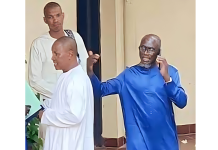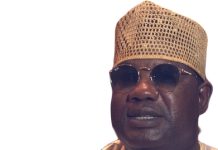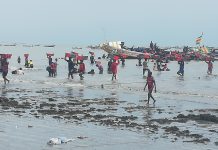By Yankuba Jallow
An ex-officer, who commanded the Police Intervention Unit (PIU) has taken responsibility for whatever happened to the students on the 10th April 2000.
The 47 – year – old former police commander said in April 2000, he was an Assistant Superintendent of Police and the officer commanding the PIU.
Momodou Ceesay, the then head of the PIU said the students were gathered peacefully at the Gambia Technical Training Institute on the 10th April 2000 and when he arrived with his men, he told them to disperse. He said the students ignored him though a few among them murmured that they wouldn’t leave.
He told the TRRC that he did not talk to any of the students to know why they were gathered at the GTTI.
“They (the students) were very peaceful to be frank with you Counsel,” Ceesay told the TRRC, adding that the students weren’t aggressive.
“It was my men who chased and beat them,” he said.
He said he ordered for his men to disperse them because the students were becoming agitated and they blocked the traffic.
“The students were chased, beaten and some of them were arrested,” Ceesay said, adding that “we dispersed them because they were blocking the traffic.”
He said: “I take full responsibility of whatever happened at GTTI on the 10th April 2000,” Ceesay said.
He said on the 9th April 2000, in the evening, he was informed by the Commander of Operation of the Gambia Police Force Baboucar Sowe that students will be embarking on a demonstration on the following day. He said the Operation Commander instructed him to prepare his men and wait for instruction. He said he was not instructed to use force on the students.
He said on the 10th April, he arrived at the PIU headquarters at 6:30 am and found his men were all dressed in their riot gears. He said he briefed his men about the mission they were supposed to carry out; that they should ensure law and order is maintained.
“None of the 50 men carried a gun,” he said.
He said his men went with helmets, tear gas and batons among others. He added that those who carried weapons were the PIU personnel who were posted on guard duties at different places such as at embassies, the IEC and other areas. He said he inspected his men and they proceeded to GTTI.
He said at GTTI, he saw students gathered as well as soldiers from the Fajara Barracks. Ceesay said he addressed the students to disperse, but they did heed to his advice.
“I could notice they were becoming agitated. I took the PA system asking them to leave and go home or else the PIU will disperse them,” he said.
He said: “I turned to the PIU and told them that the situation was becoming agitated and I asked them to disperse them (the students).”
“The time we arrived, the crowd of students was peaceful,” he said, adding that none of the members of the crowd was armed.
About the Witness
He said he joined the Gambia National Gendarmerie in 1992. He said he joined the Gambia Armed Forces after the Gendarmerie was amalgamated into the army and the police. He said he was the officer in charge of operation and logistics. He said he was deployed to the Gambia Police Force in 1995 and sent to the police training school where he trained personnel of the police intervention unit. He said in 1996, he was redeployed to the Police Intervention Unit (PIU) as officer commanding. He said it was during his reign that the PIU was first issued with weapons to use in their work. He said the police officers were trained on how to use the weapons that were issued to them. He said he was the head of the unit until January 1998 when he went to Angola for a peacekeeping mission as a United Nations police. He said he came back in January 1999 and assumed his position as the officer commanding the PIU. He said while serving as the head of the Anti-Crime, he had 3 platoons but on the day of the protest, one of the platoons.
Momodou Ceesay was born on the 21st October 1972 in Dippa Kunda and he currently works for the United Nations in Sudan.


















